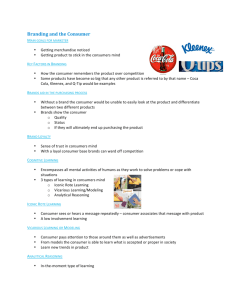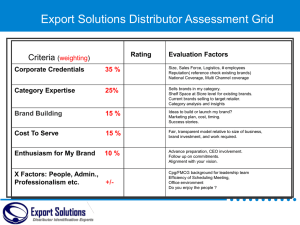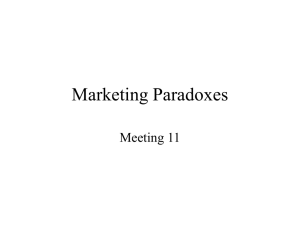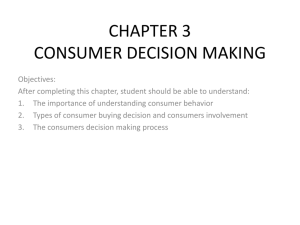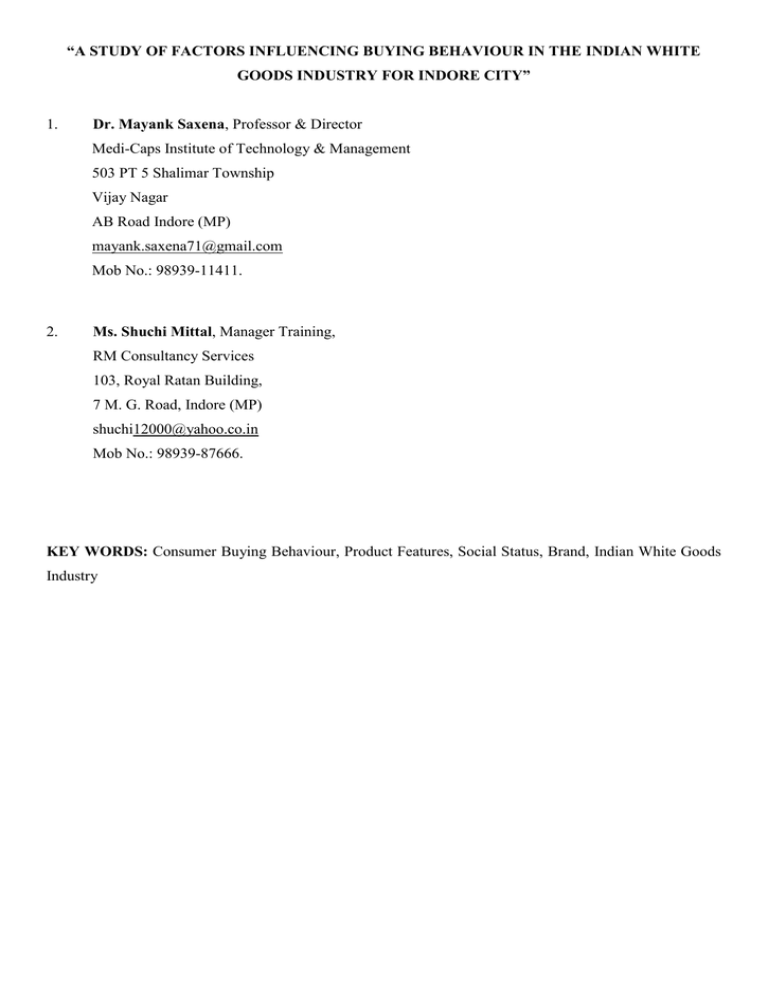
“A STUDY OF FACTORS INFLUENCING BUYING BEHAVIOUR IN THE INDIAN WHITE
GOODS INDUSTRY FOR INDORE CITY”
1.
Dr. Mayank Saxena, Professor & Director
Medi-Caps Institute of Technology & Management
503 PT 5 Shalimar Township
Vijay Nagar
AB Road Indore (MP)
mayank.saxena71@gmail.com
Mob No.: 98939-11411.
2.
Ms. Shuchi Mittal, Manager Training,
RM Consultancy Services
103, Royal Ratan Building,
7 M. G. Road, Indore (MP)
shuchi12000@yahoo.co.in
Mob No.: 98939-87666.
KEY WORDS: Consumer Buying Behaviour, Product Features, Social Status, Brand, Indian White Goods
Industry
ABSTRACT
Consumer behaviour is the process focuses on how individuals make decisions to spend their available
resources like time, money, effort on consumption-related items. To that end, this paper addresses two
fundamental research issues. Using a qualitative study, first identify the element of consumer buying
behaviour process for White Goods Industry. Second, explore the factors affecting consumer buying
behaviour. The close-ended questionnaire was developed from standard questions of relevant literature as a
research instrument. The sample size taken for the research is of 300 respondents. Results of the experiment
indicated that the overall set of independent variables was weakly associated with the dependent variable.
However, the in-depth analysis found that product features, family and social status elements were strongly
associated with the buying behaviours of Indore consumers.
INTRODUCTION
For companies to attain commercial success, it is important that managers understand consumer behaviour.
The relationship between consumer behaviour and marketing strategy is emphasised because the success of
companies’ marketing strategies depends upon managers’ understandings of consumer behaviour
(understanding of consumer behaviour is especially important during a recession (Kotler and Caslione,
2009). The study of customer behaviour is based on consumer buying behaviour, with the customer playing
three distinct roles: user, payer and buyer. Research has shown that consumer behaviour is difficult to
predict, even for experts in the field (Armstrong & Scott, 1991). Consumer behaviour involves the
psychological processes that consumers go through in recognising their needs, finding ways to solve these
needs, making purchase decisions (e.g., whether to purchase a product and, if so, which brand and where),
interpret information, make plans, and implement these plans (e.g., by engaging in comparison shopping or
actually purchasing a product). Consumer behaviour research allows for improved understanding and
forecasting concerning not only the subject of purchases but also purchasing motives and purchasing
frequency (Schiffman & Kanuk, 2007).
The study of consumer behaviour focuses on how individuals make decisions to spend their available
resources like time, money, effort on consumption-related items (Schiffman and Kanuk, 1997). The buying
process is a combination of mental and physical activities that ends with an actual purchase almost daily
(reference). Thus it is interesting to study the connection within “what we buy” and “why we buy it”. In this
scenario, brands play a leading role in customer decision making (Reference). The purchase of a product is
both mental and physical activity (Sheth & Mittal 2004, 14). These activities are called behaviours, and their
result is a combination of variety determinate by the relation within the type of customer and his/her role.
The definition of consumer behaviour given by Belch (1998) is ‘the process and activities people engage in
when searching for, selecting, purchasing, using, evaluating, and disposing of products and services so as to
satisfy their needs and desires’. Behaviour occurs either for the individual, or in the context of a group, or
an organization. Consumer behaviour involves the use and disposal of products as well as the study of how
they are purchased. Product use is often of great interest to the marketer, because this may influence how a
product is best positioned or how we can encourage increased consumption.
Howard and Sheth (1969) proposed one of the earliest models of consumer behaviour. The model integrates
various social, psychological and marketing influences on consumer choice and used to analyse purchasing
behaviour. Howard and Sheth suggested that consumer decision making differs according to the strength of
the attitude toward the available brands; this being largely governed by the consumer’s knowledge and
familiarity with the product class.
Based on the above discussion researcher mainly focused on two major questions: how consumers go about
making decisions, and how decisions should be made. It’s really tough to know a customer just by taking a
surface look or a surface descriptor such as male/female or age or ethnic group. To understand your
customers’ needs, you really have to understand their lifestyles, opinions and attitudes.
OBJECTIVE OF THE STUDY
1. To identify elements of consumer buying behaviour process for white goods.
2. To explore factors influencing consumer buying behaviour for Indian white goods industry.
RESEARCH METHODOLOGY
Research Design & Sampling design: This research study is of descriptive nature and has used the
quantitative research method. A convenience sample is employed for sampling method from Indore area and
response is taken from the students, service class, business class and professionals. Size of the universe
cannot be defined because every individual could be a respondent for this particular study. The sample size
has been consisting of 300 respondents.
The close-ended questionnaire was developed from standard questions of relevant literature as a research
instrument. However, secondary data has been collected with the help of print media like books, magazines,
research articles on Google scholars and such other websites, related company literature. The succeeding
part of the questionnaire restricted to five sections, and each section represented a variable. In this part
responses were measured on a 5-point Likert scale, ranging from one (To a slight Extent) to five (To a very
large Extent).
The statistical Package for the Social Sciences Program (SPSS) version 19.0 was used in this study for all
the statistical assessments. The data set was screened and examined for incorrect data entry, missing values,
normality and outliers. In this study, descriptive statistics are first employed and then factor analysis is
carried out by the researcher.
DATA ANALYSIS AND INTERPRETATION
Elements which Influence Purchase Decisions
The elements which influence purchase decision data were initially subjected to factor analysis separately to
explore the structure of the data. A total of 10 scale items yielded 3 significant factors; based on loadings,
the first was titled “Product Features.” As shown in Table I, it accounts for 37.26 percent of the variance in
the data and loads highly on a set of variables which include “Brand,” “Performance,” “Technology,”
“Service Warranty,” “Environmental Friendly,” and “Prestige of the Product,” This factor includes most of
the typically used descriptors of desired product features outcomes. A second distinct outcome factor
emerged from the data. Based on its loadings, this factor was titled “Family.” As shown in Table I, it
accounts for 19.714 percent of the variance in the data and loads highly on such variables as “Family,” and
“Friends.” These variables indicate a level of involvement of family & friends in influencing the purchase
decision. A third distinct outcome factor emerged from the data. Based on its loadings, this factor was titled
“Social Group.” As shown in Table I, it accounts for 12.24 percent of the variance in the data and loads
highly on such variables as “Peer Groups,” and “Social Status.” These variables indicate a level of
involvement of society in influencing the purchase decision.
Table I
Total Variance Explained
Extraction Sums of Squared
Initial Eigenvalues
Loadings
% of
Cumulative
Variance
%
Total
Rotation Sums of Squared Loadings
% of
Cumulative
Variance
%
% of
Component
Total
1
3.726
37.259
37.259
3.726
37.259
37.259
3.611
36.107
36.107
2
1.971
19.714
56.973
1.971
19.714
56.973
1.662
16.624
52.731
3
1.224
12.243
69.216
1.224
12.243
69.216
1.649
16.485
69.216
4
.759
7.587
76.804
5
.552
5.519
82.323
6
.518
5.182
87.505
7
.472
4.723
92.228
8
.313
3.127
95.355
9
.278
2.782
98.138
10
.186
1.862
100.000
Extraction Method: Principal Component Analysis.
Rotated Component Matrixa
Component
1
2
3
EPD1
.703
-.058
.414
EPD2
.126
.843
-.129
EPD3
-.068
.717
.381
EPD4
-.038
.498
.647
EPD5
.196
.019
.806
EPD6
.854
.037
.033
EPD7
.895
-.150
.057
EPD8
.770
.008
-.039
EPD9
.635
.254
-.435
Total
Variance
Cumulative %
EPD10
.728
.312
.227
Extraction Method: Principal Component
Analysis.
Rotation Method: Varimax with Kaiser
Normalization.
a. Rotation converged in 6 iterations.
Buying Behaviour Decision
The elements which influence buying behaviour decision data were initially subjected to factor analysis
separately to explore the structure of the data. A total of 12 scale items yielded 2 significant factors; based
on loadings, the first was titled “Brand Awareness.” As shown in Table II, it accounts for 42.28 percent of
the variance in the data and loads highly on a set of variables which include “The only difference between
the major brands of electronics products is price,” “Electronics products are electronics products; most
brands are basically the same,” “The major brands of electronics products are the same,” “The reliability of
the major brands of electronics products is the same,” “The level of safety of the major brands of electronics
products is the same,” “The level of success of the major brands of electronics products is the same,” “The
level of confidence in the major brands of electronics products is the same,” “The major brands of
electronics products are all equally family oriented,” “The level of honesty of the major brands of
electronics products is the same,” and “The major brands of electronics products are all equally original.”
This factor includes most of the typically used descriptors of brand awareness in consumer durables. A
second distinct outcome factor emerged from the data. Based on its loadings, this factor was titled “Brand
Comparison.” As shown in Table II, it accounts for 9.15 percent of the variance in the data and loads highly
on such variables as “To me, there are big differences between the various brands of electronics products.”
Table II
Total Variance Explained
Extraction Sums of Squared
Initial Eigenvalues
Loadings
% of
Cumulative
Variance
%
Total
Rotation Sums of Squared Loadings
% of
Variance
Cumulative %
Total
% of
Cumulative
Variance
%
Component
Total
1
5.074
42.282
42.282
5.074
42.282
42.282
3.262
27.182
27.182
2
1.392
11.600
53.882
1.392
11.600
53.882
3.182
26.514
53.696
3
1.097
9.146
63.028
1.097
9.146
63.028
1.120
9.332
63.028
4
.948
7.903
70.931
5
.807
6.726
77.657
6
.709
5.911
83.569
7
.525
4.372
87.941
8
.439
3.658
91.599
9
.310
2.584
94.183
10
.289
2.405
96.588
11
.219
1.823
98.411
12
.191
1.589
100.000
Extraction Method: Principal Component Analysis.
Rotated Component Matrixa
Component
1
2
3
BBD1
.653
-.011
-.217
BBD2
-.004
-.069
.927
BBD3
.743
.265
-.027
BBD4
.776
.381
.137
BBD5
.840
.129
.133
BBD6
.617
.437
.057
BBD7
.147
.652
-.109
BBD8
.289
.620
-.035
BBD9
.312
.783
-.115
BBD10
.329
.598
.344
BBD11
-.007
.862
.072
BBD12
.532
.482
.152
Extraction Method: Principal Component
Analysis.
Rotation Method: Varimax with Kaiser
Normalization.
a. Rotation converged in 4 iterations.
Factors Influence Purchase Decisions
The factors which influence purchase decision data were initially subjected to factor analysis separately to
explore the structure of the data. A total of 10 scale items yielded 3 significant factors; based on loadings,
the first was titled “Product Promotion.” As shown in Table III, it accounts for 32.27 percent of the variance
in the data and loads highly on a set of variables which include “I shop a lot for specials (products on
sale/discounts/offers) when purchasing,” “I consider design of the product as an important factor,” and
“Advertised brands are better than non advertised brands,” This factor includes most of the typically used
descriptors of offers and promotion activities attached with the product. A second distinct outcome factor
emerged from the data. Based on its loadings, this factor was titled “Brand Loyalty.” As shown in Table III,
it accounts for 15.31 percent of the variance in the data and loads highly on such variables as “I tend to buy
the same brand (for the chosen product category) again and again,” “I prefer a particular brand only (for the
chosen product category),” “I consider quality stability as an important factor,” and “Ease to handle a
product is an important factor while purchasing.” These variables indicate a loyalty towards a single brand
which influencing the purchase decision. A third distinct outcome factor emerged from the data. Based on its
loadings, this factor was titled “Product Information.” As shown in Table III, it accounts for 11.1 percent of
the variance in the data and loads highly on such variables as “I spend considerable time in information
gathering before product purchase,” and “I prefer brands with after sales service while purchasing.” These
variables indicate a level of information gathering in influencing the purchase decision.
Table III
Total Variance Explained
Extraction Sums of Squared
Initial Eigenvalues
Loadings
% of
Cumulative
Variance
%
Total
Rotation Sums of Squared Loadings
% of
Component
Total
1
3.227
32.273
32.273
3.227
32.273
32.273
2.190
21.900
21.900
2
1.531
15.314
47.588
1.531
15.314
47.588
2.117
21.171
43.071
3
1.109
11.095
58.683
1.109
11.095
58.683
1.561
15.612
58.683
4
.971
9.714
68.397
5
.793
7.933
76.330
6
.688
6.875
83.205
7
.599
5.991
89.196
8
.562
5.620
94.816
9
.288
2.881
97.696
10
.230
2.304
100.000
Extraction Method: Principal Component Analysis.
Rotated Component Matrixa
Component
1
2
3
FPD1
.396
.266
.136
FPD2
.298
.644
.163
FPD3
.433
.591
-.267
FPD4
-.076
.709
.269
FPD5
.821
.015
.180
FPD6
.613
.452
-.006
FPD7
.226
.103
.829
FPD8
.805
-.028
.011
FPD9
.032
.700
.203
FPD10
.004
.273
.782
Extraction Method: Principal Component
Analysis.
Rotation Method: Varimax with Kaiser
Normalization.
a. Rotation converged in 6 iterations.
Variance
Cumulative %
Total
% of Variance
Cumulative %
CONCLUSION
This research contributes to the understanding of consumer buying behaviour in the consumer durables
market. The major findings of the study indicated that the overall set of independent variables was weakly
associated with the dependent variable. However, the in-depth analysis found that product features, family
and social status elements were strongly associated with the buying behaviours of Indore consumers. The
buying behaviour is also influenced by brand awareness among consumers and alternatives of brands
available in the market. The analyses discover in consumer decision-making is that product promotion,
brand loyalty and product information plays an important role while purchasing consumer durables.
APPENDIX 1: QUESTIONNAIRE
QUESTIONNAIRE
'This questionnaire is to gather data for the doctoral study ‘A Study of Consumer Buying Behaviour in
Indian White Goods Industry’. Your views based on practical experience count much. Without your free
and frank views it will not be possible to materialize this study. You are requested to answer by placing a
'tick' rnark in the appropriate response column. Information supplied by you will be kept strictly confidential
and will be put to use only for this research work. Your kind cooperation is indispensable for this work and
it is greatly appreciated.
Thank You.
Personal Profile
1. Name: [Optional]
2. Age [In completed Years]
3. Sex: Male / Female
4. Occupation:
5. Educational Qualification [Please tick all (the qualifications you possess]
-
Pre degree
- Degree
-
Degree and Diploma
- PG
-
PG and Diploma
- MBA or MCA
-
ICWAI or CS or CFA
- Others [specify]
6. What brand do you prefer while purchasing consumer durables?
LG
Samsung
Sony
Panasonic
Videocon
Others (please specify)
7. How do you become aware of various consumer durable brands?
Q.
Print Ads
Newspaper
TV Commercials
Word of mouth
Internet
Please tick the appropriate boxes or state your level of agreement:
S.No. Statement
What
To
influencing
a To
your very
purchase decisions while Slightly
purchasing
a To
To
a To a
slight
some
large
very
extent
extent
extent
large
Consumer Extent
Comments
extent
Durables
1
Brand
EPD1
2
Family
EPD2
3
Friends
EPD3
4
Peer
Groups
(Social
EPD4
Group)
5
Social Status
EPD5
6
Performance
EPD6
7
Technology
EPD7
8
Service Warranty
EPD8
9
Environmental Friendly
EPD9
10
Prestige of the product
EPD10
Q.
Please tick the appropriate boxes or state your level of agreement with the following Statements:
S.No Statement
Strongl
Buying behaviour decision y
for Consumer Durables
Disagre
e
Somewhat Neither
Somewhat
Strongl
Disagree
Agree
y Agree
Comments
1
I can’t think of any difference
BBD1
between the major brands
2
To
me,
there
differences
are
big
between
the
BBD2
various brands of electronics
products.
3
The only difference between
the
major
brands
BBD3
of
electronics products is price.
4
Electronics
electronics
products
products;
are
BBD4
most
brands are basically the same.
5
The
major
brands
of
BBD5
electronics products are the
same.
6
The reliability of the major
BBD6
brands of electronics products
is the same.
7
The level of safety of the
BBD7
major brands of electronics
products is the same.
8
The level of success of the
BBD8
major brands of electronics
products is the same.
9
The level of confidence in the
BBD9
major brands of electronics
products is the same.
10
The
major
brands
of
BBD10
electronics products are all
equally family oriented.
11
The level of honesty of the
BBD11
major brands of electronics
products is the same.
12
The
major
brands
of
electronics products are all
equally original.
BBD12
Q.
Please tick that best describes factors influencing your purchase
decisions in case of Consumer
Durables using the scale given below:
S.No. Statement
To
a To
a To
To a To a
Comment
large
s
very
slight
some
Slightl
extent
extent extent large
y
very
extent
Extent
1
I consider price as an important factor
FPD1
while purchasing
2
I tend to buy the same brand (for the
FPD2
chosen product category) again and
again
3
I prefer a particular brand only (for
FPD3
the chosen product category)
4
I consider quality stability as an
FPD4
important factor
5
I shop a lot for specials (products on
sale/discounts/offers)
FPD5
when
purchasing
6
I consider design of the product as an
FPD6
important factor
7
I
spend
considerable
time
in
FPD7
information gathering before product
purchase
8
Advertised brands are better than non
FPD8
advertised brands
9
Ease to handle a product is an
FPD9
important factor while purchasing
10
I prefer brands with after sales service
while purchasing
FPD10
REFERENCES:
Al-Rajhi, Khalid Sulaiman (2008) ‘The effects of brands and country of origin on consumers' buying
intention in Saudi Arabi’, PhD thesis.
Armstrong, J. S. (1991) ‘Prediction of Consumer Behavior by Experts and Novices’, Journal of
Consumer Research, 18(2), 251-256.
Howard, J. A., et al. (1969) ‘The Theory of Buyer Behaviour’. London: John Wiley and Sons, Inc.
Kotler, P., Caslione, J. (2009) ‘How Marketers Can Respond to Recession and Turbulence’, Journal
of Consumer Behavior, 8(2), 187-191.
Schiffman, L. G., Kanuk, L. L. (2007) ‘Purchasing Behavior’ (9th ed.). Upper Saddle River, NJ:
Pearson Prentice Hall.
Sharma, Kiran, (2012) ‘Impact of affective and Cognitive processes on impulse buying of
consumers’, thesis PhD, Saurashtra University
Sheth, J.N. & Mittal, B. (2004) ‘Customer Behavior: A Managerial Prospective’, 2nd Edition SouthWestern. Mason (USA)


